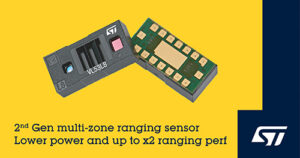- The VL53L8 direct Time-of-Flight (dToF) sensor is ideal for smartphones as well as smart speakers, human-machine interfaces, consumer LiDAR, and AR/VR/MR
- Sensor combines new revolutionary metasurface lens technology with a more powerful and efficient laser and improved on-chip processing
Aug 3, 2022 – STMicroelectronics (NYSE: STM), a global semiconductor leader serving customers across the spectrum of electronics applications, has announced its newest FlightSense™ Time-of-Flight (ToF) ranging sensor for smart-phone camera management and augmented/virtual reality. With significant enhancements to many key components, ST’s latest ToF module offers up to double the ranging performance – up to 4m in all zones indoors — while reducing the power consumption by half compared to the previous-generation device, when operating in common conditions.

“ST’s ToF technology has enjoyed massive commercial success, now shipping in more than 200 smartphone models and 100 PC, projector, and robotic products. Now, VL53L8 FlightSense sensor takes ranging performance and power efficiency to new levels,” said Eric Aussedat, Executive Vice President and General Manager of the Imaging Sub-Group within ST’s Analog, MEMS and Sensors Group. “Our latest-generation ranging sensor is a game changer. With its innovative metasurface lens technology and power-efficient architecture, it reduces battery loading, extends camera autofocus ranging, and enhances scene-understanding features.”
Developed in partnership with Metalenz, the world’s first optical metasurface technology enables optical systems to collect more light, provide multiple functions in a single layer, and deliver new forms of sensing in smartphones and other devices, all in its compact package.
The VL53L8 is ideal for smartphones and tablets in both user-facing and world-facing applications, but also for accessories in the personal electronics segment like smart speakers and AR/VR/MR. The user-facing applications include object tracking and gesture recognition. World-facing applications include laser-autofocus, camera selection, touch-to-focus, and flash dimming – the VL53L8 will deliver even greater benefit to these features in low-light conditions. The sensor can also support indoor/outdoor detection and smart-focus bracketing, as well as consumer LiDAR, where depth mapping is required.






